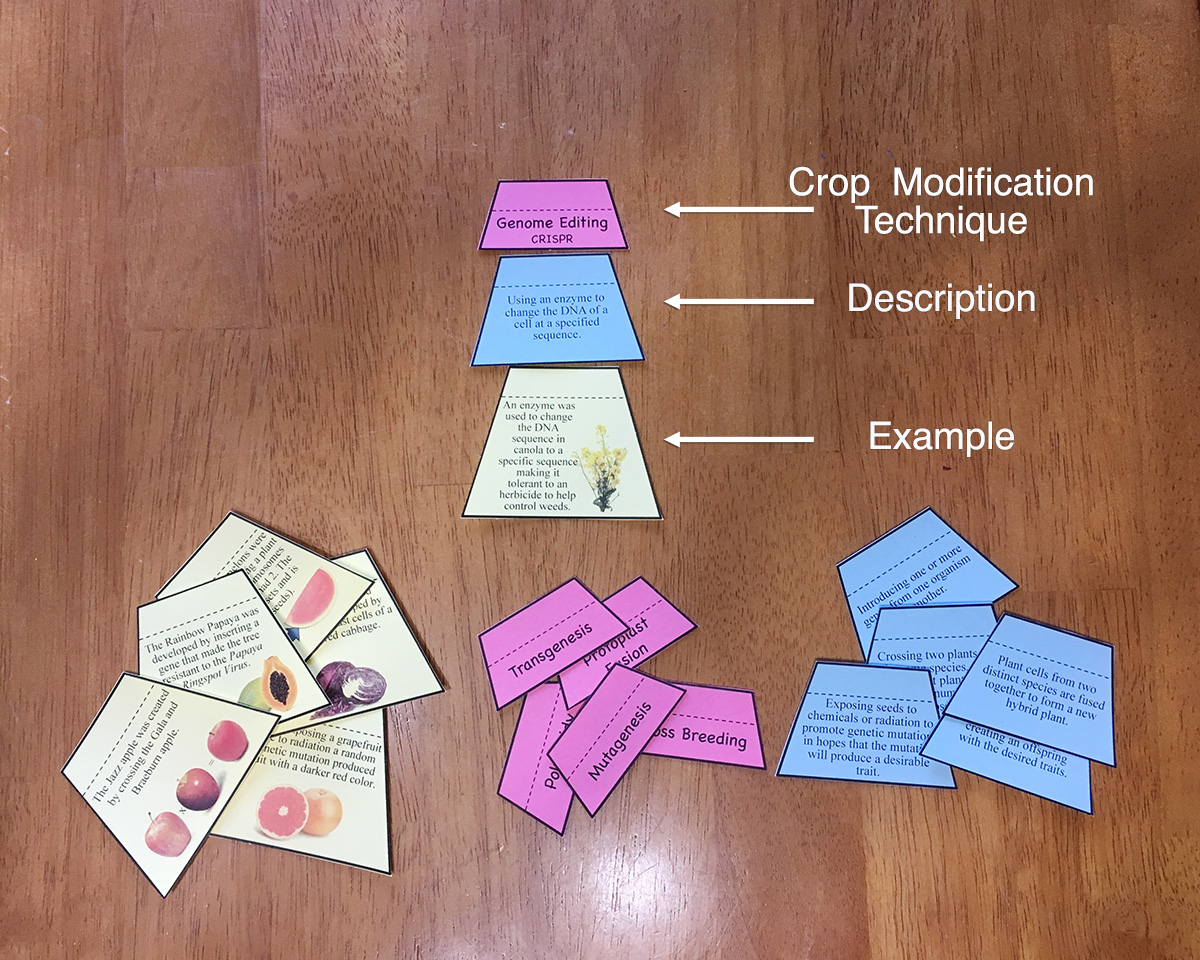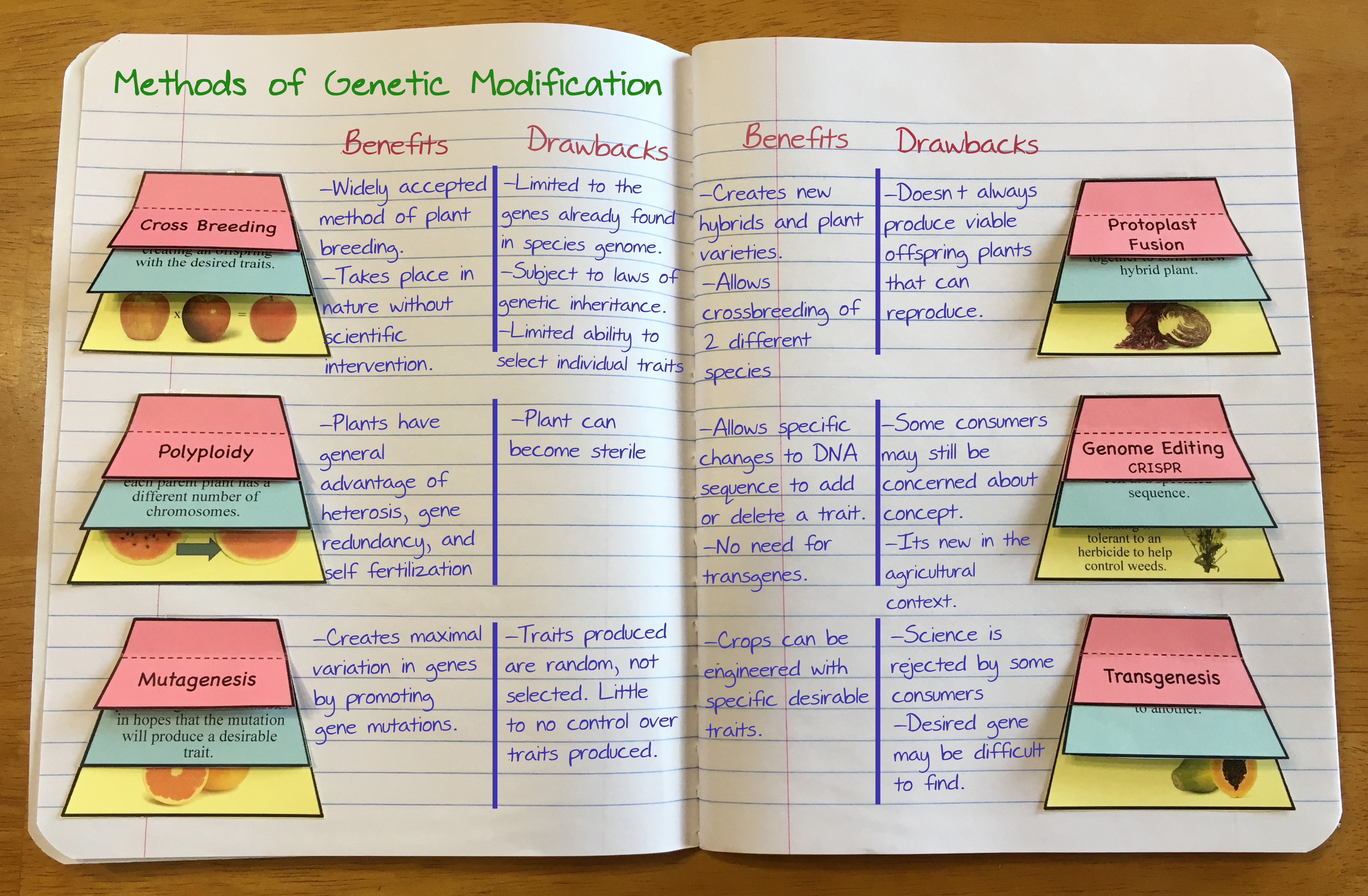Agricultural Literacy Curriculum Matrix
Lesson Plan
Methods of Crop Modification
Grade Level
9 - 12
Purpose
Explore six scientific processes that can be used in plant breeding to modify the genotype of a plant in the pursuit of desired characteristics.
Estimated Time
1 hour
Materials Needed
Engage:
Explore and Explain:
- Crop Modification Interactive Notebook Pages, 1 set of layered tabs per student, printed one-sided
- Note: page one is formatted to provide copies for 4 students per page; page two, 2 students per page; page three, 1 student per page
- Scissors and tape, glue, or staplers
- Interactive notebooks OR blank sheet of paper, 1 per student
- Comparing Methods of Genetic Modification in Plants Table
Vocabulary
crossbreeding: selectively breeding two plants or animals of different breeds or cultivars to produce a superior offspring sometimes called a hybrid
farming: the activity or business of growing crops and raising livestock
mutagenesis: a method of selective breeding in plants where seeds are exposed to chemicals or radiation to promote DNA mutations that could result in developing new traits in offspring plants
polyploidy: cells and organisms containing more than two paired (homologous) sets of chromosomes
protoplast: a plant, bacterial, or fungal cell that had its cell wall completely or partially removed using either mechanical or enzymatic means
transgenesis: the process of introducing an exogenous gene, called a transgene, to a living organism
Did You Know?
- Farmers began cross breeding plants in the 1700s to perpetuate ideal plant characteristics.1
- Herbicide- and insect-resistant crops began introduction and adoption in 1996 using the science of transgenesis.2
Background Agricultural Connections
Plant breeding and the domestication of plants dates back 9,000 to 11,000 years ago4 when humans initially began the practice of farming. The introduction of farming allowed civilizations to stay in one place, rather than hunting and gathering their food on a constant move. Early farmers selected food plants with desirable characteristics to cultivate and provide their food supply. With each generation, plants with the best characteristics were chosen and crops improved. Knowledge of science and genetics advanced through the work of scientists such as Gregor Mendel. Modern plant breeding uses the same principles with the addition of advanced technology and ever-advancing knowledge of genetics. The average diet consists of food produced by plants that have been developed and improved through a variety of plant modification methods.
Cross breeding has been practiced since the beginning of farming and utilizes the laws of inheritance to guide the specific selection of desirable traits in plants.5 After a desirable plant is selected, the pollen from one plant is placed on the female portion of the flower of another desirable plant which leads to the production of seeds that are hybrids of the two parent plants. This process is repeated with each generation of plants slowly moving toward an improved species. Plants with chosen characteristics are perpetuated and those without are removed. Genetic mutations occur naturally and randomly in the genomes of plants and animals. These result from the spontaneous deletion, addition, or insertion of base units in DNA. Mutagenesis is a plant breeding method which utilizes mutations as a method of creating genetic diversity. Plant breeders expose plants to mutating chemicals or radioactivity to increase the likelihood of mutations to occur which may create desirable characteristics in plants.5 Polyploidy is the occurrence of more than two sets of chromosomes. It can occur naturally or be induced through the use of chemicals. Polyploidy can increase fruit size or be used to create sterile varieties of a plant such as a seedless watermelon.5 Protoplast fusion is an artificial version of cross breeding that fuses the pollen of one plant species with the ova in the flower of another species. This allows the moving of beneficial traits from one species to another by fusing the protoplasts.6 Transgenesis is the process of introducing one or more genes into an organism from another entirely separate organism by finding and isolating a chosen gene and adding it to the genome. Genome editing uses an enzyme to change the DNA of a cell at a specified sequence. CRISPR-Cas9 is a specific gene editing tool that helps plant breeders integrate desirable traits with more efficiency and precision than before. It is a promising and developing technology.5 The understanding of the CRISPR system began in 1987, but it did not gain momentum until 2012 when scientific research began being published about it.7 CRISPR is now being studied for its medical benefits to decrease human diseases as well as to improve the food we eat.
Plant breeders often use one or more modification methods before ultimately achieving their goal. Each method of plant modification comes with both advantages and disadvantages or limitations. Not every method will be effective in every situation. Regardless of the method or methods used, all plants are screened for overall safety before a seed variety is available on a commercial level.8
| Modification Method | Advantages | Disadvantages/Limitations |
|---|---|---|
| Cross Breeding |
|
|
| Mutagenesis |
|
|
| Polyploidy |
|
|
| Protoplast Fusion |
|
|
| Transgenesis |
|
|
| Genome Editing (CRISPR) |
|
|
Engage
- Watch Foods That Originally Looked Totally Different. As the students watch the video clip, have them jot down a list of scientific processes they are already familiar with.
- Following the video draw on prior knowledge and review the following:
- Selective Breeding
- Genotype
- Phenotype
- Traits
- Explain that selective breeding has facilitated many improvements in the production of our food. However, more advanced science can also be used in plant breeding to achieve desired characteristics.
Explore and Explain
- Pass out one copy of the Crop Modification Interactive Notebook Pages. Instruct students to cut out the pieces of the layered tabs.
- As students are cutting out their layered tabs, draw on their prior knowledge and review basic concepts of inheritance and genetics. Students should be able to distinguish the difference between phenotype and genotype, understand basic principles of genetic inheritance from parent to offspring, and recognize the difference between dominant and recessive genes.
- After reviewing the vocabulary and principles above, explain to the class that there are numerous methods plant scientists can use to improve plants.
- Brainstorm examples of genetic traits that could be desirable in plants. Examples include:
- Drought tolerance
- Resistance to plant disease
- Resistance to pests
- Nutrition content of edible plant parts (fruits, vegetables, or grains)
- Flavor or texture
- Size or color of flowers or leaves (for ornamental plants)
- Instruct students to work individually or in groups to match the three layered tabs that represent: 1) crop modification technique, 2) its description, and 3) an example of each of the six different modification methods.

- After students have had a chance to match these to the best of their ability, review each method. Discuss each plant modification method, applying what students already know about genetic traits, DNA, and inheritance.
- Have each student place the layered tabs inside their interactive notebook OR on a blank sheet of paper (if you don’t use interactive notebooks), matching the correct modification method, description, and example.
- As a class, discuss the benefits and potential drawbacks of each plant modification method. Instruct students to keep notes about each method as you go about your discussion (see example pictured below). Share the Comparing Methods of Genetic Modification in Plants Table.
- Ask students the following questions to gather their thoughts and existing perceptions:
- Which method is best?
- Which method is least desirable?
- Which method do you think would be most efficient in creating plant varieties to produce a healthy and abundant food supply?
- Summarize with students that our scientific knowledge of genetics and inheritance has allowed us to improve and change crops to be healthier (more resistance to disease and pests), to utilize natural resources (such as water and soil nutrients) more efficiently, and to improve the overall quality and taste of our food. Review the benefits and drawbacks of each method, helping students understand that each method has limitations and applications for different circumstances.
Three Dimensional Learning Proficiency
|

Teach with ClarityIt is critical for students to understand that no single modification method can be used successfully to reach the goals of ALL farmers and consumers. Each method has benefits and drawbacks unique to every plant. For example polyploidy is a benefit in the seedless watermelon, but it could be a drawback in another plant if it increases the size of the fruit and causes it to become watery in flavor. |
Evaluate
Review the crop modification methods with the following questions:
- Which method uses an enzyme to literally change the genetic code (it has the ability to literally edit a genetic sequence like a typewriter)? (genome editing- CRISPR)
- Which method increases the number of chromosomes? (polyploidy)
- Which method promotes genetic mutations in hopes of randomly generating a new and desired gene? (mutagenesis)
- Which method transfers a desired gene from one species to another? (transgenesis)
- Which method takes place without scientific intervention and involves specifically cross pollinating two plants with the purpose of improving each generation of plants? (cross breeding)
- Which method uses biotechnology to fuse the cells of two different species? (protoplast fusion)
- Summarize the following key concepts:
- Technology enhances the ability to create plants that meet our needs and overcome challenges (disease, drought, pests, etc.) in the food system.
- There are several scientific techniques used to change and improve the genetic traits of plants. All techniques have advantages and challenges.
- No single plant breeding method is best or most effective for every plant and every desired trait.
Sources
- https://www.ers.usda.gov/data-products/adoption-of-genetically-engineered-crops-in-the-us.aspx
- https://gmoanswers.com/ask/when-did-humans-first-start-genetically-modify-food-and-why
- http://www8.nationalacademies.org/onpinews/newsitem.aspx?RecordID=23395
- https://en.wikipedia.org/wiki/History_of_plant_breeding
- https://www.biofortified.org/2015/07/crop-modification-techniques-infographic/
- http://www.biologydiscussion.com/plants/protoplasts-plants/protoplast-fusion-meaning-methods-and-its-mechanisms/26481
- http://www.acsh.org/news/2016/04/22/crispr-edited-foods-coming-to-a-store-near-you-soon
- https://www.nap.edu/read/10977/chapter/5#43
Recommended Companion Resources
Author
Andrea Gardner
Organization
National Center for Agricultural Literacy (NCAL)
| We welcome your feedback! If you have a question about this lesson or would like to report a broken link, please send us an email at matrixelearning@gmail.com. If you have used this lesson and are willing to share your experience, we will provide you with a coupon code for 10% off your next purchase at AgClassroomStore. |
